With most spiritual places, Tibet is vast to explore. This in-depth trip will take you to Lhasa, Gyantse and Shigatse which are regarded as Golden Triangle of Tibet. Starting from Lhasa, you will meet the imposing palace, sacred monasteries, and devoted Tibetan People. Then turn to Heroic City Gyantse, historical Shigatse, and extremely beautiful Namtso. Your tour must be both spiritual and awe-inspiring as you pass the glittering mountain and turquoise lakes.
Highlights of this tour:
- Experience authentic Tibetan culture by visiting the most unique Buddhist monasteries and sites, such as Potala Palace, Jokhang Temple, Sera Monastery, etc;
- Explore the mysterious Palacho Monastery where three insects of Tibetan Buddhism coexist harmoniously and the Tashilhunpo Monastery which is the official seat of the Panchen Lama;
- Join in the pilgrims and make a kora around the beautiful and legendary Namtso.
Tour Brief Information
- Tour price: from
- Tour code: TD-EX-03
- Tour Type: Private Customizable Tour Package
- Destination: Lhasa / Gyantse / Shigatse / Namtso / Lhasa
- Duration: 7 days and 6 nights
- Departure: Flexible
- Travel Theme:




- Best Time:


- Physical Level
- Tour Pace
- Max Altitude
5,190m
- Itinerary Details
- Price Guide & Booking
- Trip FAQs
- Reviews
- Make an Enquiry
Your tour - at a glance
Day 1 Lhasa Arrival
Day 2~3 Lhasa City Tour
Day 4~5 Lhasa - Gyantse - Shigatse - Lhasa
Day 6 Lhasa - Namtso - Lhasa
Day 7 Lhasa Departure
Itinerary Details - Day by Day
Day 1 Lhasa Arrival
Welcome to the roof of the world! You will be picked up by local tour guide at the airport hall or train station, then be escorted to your hotel in Lhasa city in a private vehicle.
Tips: The altitude in Lhasa is about 3,650m above sea level. Take time out to relax and acclimate to the high altitude after arrival at your hotel. We recommend that you avoid strenuous activity for the first few days. It is advisable that you not take showers. For first time visitors, it is common to have different degrees of high altitude sickness symptom. Drink more water, have fresh fruit and plenty of rest will help to prevent the sickness. Have a good rest tonight, and get ready for tomorrow’s journey.
Day 2 Lhasa ( B )
Start today’s Lhasa exploration with an exciting visit to the landmark - Potala Palace which is regarded as one of the most beautiful architectural building in the world. You will climb up the palace along the zigzag stone paths with white-and-red walls to the top of the palace where you can not only appreciate the exotic Tibetan-style architecture, but also get a great view of Lhasa’s urban areas, then walk into the inner space of Potala Palace to explore the stately chapels and learn about the history of the palace.
Continuing your exploration, you will then get to Jokhang Temple which is considered as the spiritual heart of Tibetan Buddhism. Each day, there are thousands of pilgrims coming from different places in Tibet to the temple to worship to the Buddha. This temple is also known as the “house of Buddha” because it keeps the precious Jowo Rinpoche, the life-sized (5 foot/1.5m) image of the Shakyamuni at the age of 12. The last site for today’s exploration is the famous Barkhor Street. It is a circular and wide street encircling the Jokhang Temple. The local people like to walk on the street for several circles usually in the late afternoon as a daily tradition of pilgrimage. The street also has many shops selling a wide variety of traditional Tibetan goods, religious items and handcrafts.
Tips of Today: 1) there are 1,080 steps up to climb to the top of Potala Palace, so don’t walk in a rush, which may cause high altitude sickness; 2) taking photos is not allowed inside the palace; 3) today you will be mainly outside, please bring some water, a hat, sun cream, and sun glasses with you.
-
 Potala Palace in Spring
Potala Palace in Spring
-
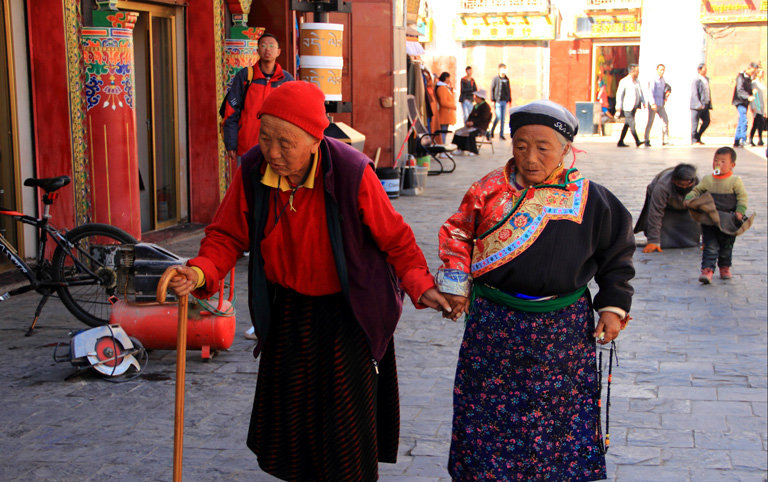 Old Tibetan Women on the Barkhor Street
Old Tibetan Women on the Barkhor Street
-
 Golden Roof of Jokhang Temple
Golden Roof of Jokhang Temple
Day 3 Lhasa ( B )
After breakfast, you will firstly go to visit the beautiful Norbulingka which used to be the former summer palace of Dalai Lamas in the ancient time, and now is a public park. It is famous for its Potrang, the private palaces of former Dalai lamas with grandiose Tibetan architecture style. Next, drive several kilometers to the western outskirts of Lhasa to visit Drepung Monastery. Drepung, in Tibetan, means “prosperity”. Since its establishment, Drepung Monastery has always been one of the most important Buddhist monasteries in Tibet. In its heyday, there were more than 10,000 monks lived and studied in the monastery. Throughout its history, many important and famous Tibetan leaders used to study here, especially the Dalai Lamas. So Drepung Monastery is also respectfully known as the “Mother School of Dalai Lamas”.
In the afternoon, you will be taken to another famous monastery in Lhasa - Sera Monastery. It is famous for the spectacular “Buddhism Debating”. As a daily routine, the monks gather in a courtyard, and debate on the Buddhist doctrines with supplemented gestures, which is thought to be helpful to facilitates better comprehension of the Buddhist philosophy to attain higher levels of study. After enjoying the "Buddhism Debating", you will be transferred back to the city. The rest time is your own free time to rest.
The Etiquette of Visiting Monastery: 1) you shouldn’t wear short and uncover shoulders; 2) taking off your sunglasses and hat before entering the chapels; 3) taking photos is usually not allowed inside the chapels.
-
 Enjoy the scripture debate in the Sera Monastery
Enjoy the scripture debate in the Sera Monastery
-
 Monks Gathered at the Entrance of Drepung Monastery
Monks Gathered at the Entrance of Drepung Monastery
-
 Norbulingka Park is a good summer resort in Lhasa
Norbulingka Park is a good summer resort in Lhasa
Day 4Lhasa – Gyantse - Shigatse ( B )
Today, you will leave Lhasa and drive about 8 hours to Shigatse, the second largest city in Tibet. It may be a long journey, but there are many things to do along the road. The first site you will reach is the holy Yamdrok Lake. As the largest fresh lake in the northern of the Himalaya Mountains, it spreads about 675 square meters from south to north, like an eardrop lying in the arms of snow-capped giant mountains. Viewing from a distance, you can see fertile pastures full of yaks and sheep, and some small Tibetan villages along the lakeshore. Keeping driving not so far from Yamdrok Lake, you will see the imposing Karola Glacier towering aloft on the right side of the road.
Continuing your trip, you will get to the historical city of Gyantse. Feel hungry? Have a good lunch in the town, then go to visit the mysterious Palcho Monastery. The monks and tradition of three important sects of Tibetan Buddhism - Sakyapa, Zhalupa and Gelukpa, peacefully coexist in this monastery. Its Kumbum, which is 35 meters high and has 76 small chapels with hundreds images of Kriyatantras , is believed to be the largest such structure in Tibet.
After the Gyantse sightseeing, keep drive about 3 hours, you will arrive at your hotel in Shigatse. Have a good rest!
Tips of today: 1) wear warm clothes to prevent from cold and wild; 2) pack some food and drinks with you because you will spend much time on the road.
-
 White Pagoda of Palcho Monastery
White Pagoda of Palcho Monastery
-
 Yamdrok Sheep Flocks
Yamdrok Sheep Flocks
-
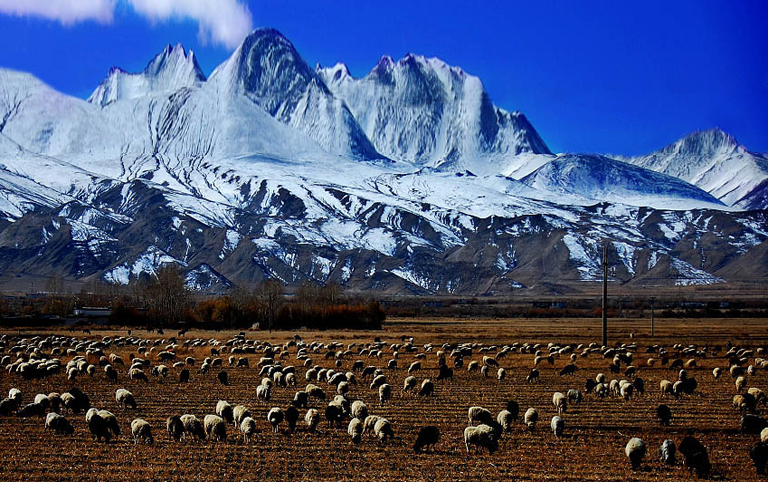 Black rocks of Karola Glaceier are contrasting starkly with the surrounding snow-capped peaks
Black rocks of Karola Glaceier are contrasting starkly with the surrounding snow-capped peaks
Day 5 Shigatse - Lhasa ( B )
Today, before you driving back to Lhasa, you will go to visit the most important monastery in Shigatse region - Tashilunpo Monastery where you will spend about 2 hours for visiting.
Tashilumpo Monastery is the seat of successive Panchen Lamas, aslo one of the six Gelug monasteries. Founded by the First Dalai Lama in 1447, its name means "all fortune and happiness gathered here" or "heap of glory" in Tibetan. Covering an area of nearly 150,000 square meters, the monastery has more than 57 halls and 3600 rooms. Among them, the Coqen Hall can hold 2000 people chanting at the same time. Featuring an interesting sprawling amalgam of traditional Tibetan monastic style, those halls, chapels and other structures are connected by precipitous steps and narrow cobblestone alleys. The interplay between the golden roofs and the white, red and black exterior walls creates a striking composition.
Leave Shigatse and head for Lhasa. On the halfway, you will take a visit to Nyemo Tunba which was the home of Tunmi Sangbuzha who invented the Tibetan character as well as the famous Tibetan Tibetan Incense. Here in Tunba, you also have chance to witness the process of making Tibetan Incense with water mill. At the same time, the scenery here is fabulous - ancient cypress trees, green willows, murmuring river...
Take a good rest in Lhasa city.
-
 Tashilhunpo Monastery is the oldest and largest Gelugpa Monastery
Tashilhunpo Monastery is the oldest and largest Gelugpa Monastery
-
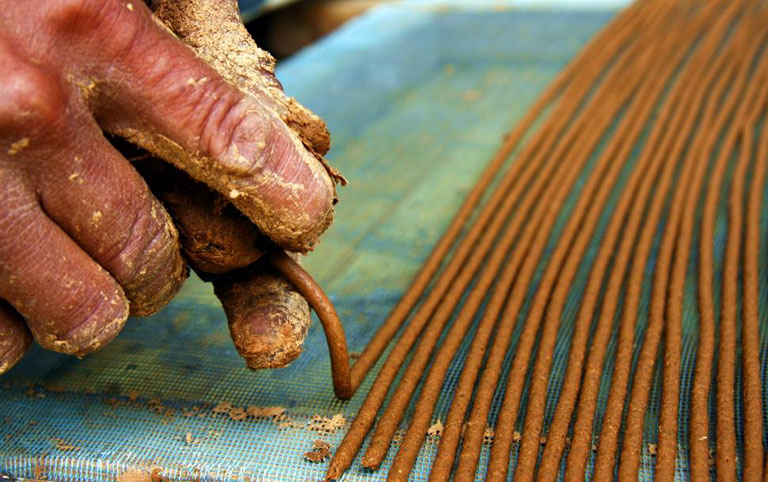 A worker is making Tibetan Incense
A worker is making Tibetan Incense
Day 6 Lhasa - Namtso ( B )
Want to explore some other features of Tibet instead of the monasteries? Let's take an exciting trip to the holy lake Namtso which is about 5 hours driving from Lhasa City. You will arrive at Namtso Lake around the early afternoon. Take some rest and throw yourself into the incredible landscape of holy lake.
Namtso Lake is the highest saltwater lake in the world with an altitude of 4718 meters, also the second largest saltwater lake in China (after the Qinghai Lake). It’s quite common for tourists who are awestruck at the Namtso at the first sight. With the snowy mountains in the background, the crystal-clear dazzling blue water, Namtso is stretching to the horizon. In clear days, the lake looks like a beautiful turquoise surrounded by magnificent snow-capped Tanggula Mountains, and the lakeshore is green, wide and open, dotted with tents, yaks and sheep of local nomads. For travelers, Namtso is the ideal place for photography, while for Tibetans, it is a scared and magical lake for pilgrimage.
Lastly, drive back to Lhasa for accommodation.
Tips of Today: The altitudes of Namtso Lake region is about 5, 000 meters, so you should be fully prepared for high altitude sickness. Do remember to keep warm all the time and avoid strenuous activity.
-
 Flags fly along Namtso Lake
Flags fly along Namtso Lake
Day 7 Lhasa Departure ( B )
Today is free for you until your tour guide transfer you to the airport in time for your flight or drop you off at Lhasa train station.
Tips of Today: 1) please pack your luggage carefully, especially for small things like camera charger, power adaptor, mobile phone, phone charger, wallet and towel; 2) If your flight is arranged in the afternoon, please make sure you check out the hotel before 12pm.
Useful Trip Notes
- 1. Tibet Permits
There are several permits required to visit Tibet. Tibet Entry Permit, issued by Tibet Tourism Bureau, is the most important one which has to be obtained before your trip because you must have it to take your flight/train to Tibet. To get the permit, you have to book a Tibet tour with us, and send us your passport and Chinese visa about 20 days in advance, and then let us apply for the permit (all Tibet permits can only be applied by travel agency). If you travel to other prefectures like Shigatse, Nyingchi, Shannan, etc, you also have to obtain an Alien Travel Permit. If you travel to Mount Everest, you have to obtain a Border Permit. (Tibet Discovery, with office in Lhasa, has always kept up with the latest news on Tibet Permits. Traveling with us, all your permits are guaranteed as long as you are qualified to the requirements.) - 2. Available Months to Visit Tibet
Generally speaking, months from May to October are recommended. Other months are usually very cold, and possible have heavy snow, especially in regions like Mount Everest, Mount Kailash, Namtso Lake, etc. - 3. High Altitude Sickness
The average altitude of Tibet is about 4000 meters above the sea level (Lhasa: 3700m; EBC: 5200m; Namtso: 4718m). You may suffer a bit from High Altitude Sickness in the beginning days of your Tibet trip if you haven’t had rich high plateau travel experience. But don’t worry too much, the high altitude can be acclimatized usually in 2~3 days. Our suggestion is to take a physical examination and get suggestions from your doctor, and also bring some medicines to prevent from High Altitude Sickness before your trip. While in Tibet, you should keep warm all the time, avoid strenuous activities, drink more water and eat more vegetables and carbohydrates. You’d better not take showers during the first two days after your arrival at Tibet. If you don’t feel well, get help from your tour guide or go to the hospital without any delay. - 4. How to Go to Tibet
Basically you have two options – flight and train. Currently, you can take a flight to Lhasa from Beijing(4.5hrs), Xian(3.7hrs), Chengdu(2.5hrs), Chongqing(3hrs), Kuming(3hrs), etc. Among all these cities, Chengdu and Xian have more frequent flights to Lhasa.
If you a train travel, you can take a train to from Beijing(40.5hrs), Xian(32hrs), Chengdu(43hrs), Shanghai(47hrs), Chongqing(42hrs), Lanzhou(25hrs), Xining(22hrs), Guangzhou(54hrs). - 5. Packing and Wearing Ideas
Firstly you can’t forget your passport and Chinese Visa. A large backpack and a smaller one are recommended (the smaller one can be used for daily activities). Also bring the necessary medicine you need. Other stuffs like sunglasses, snow glasses, hats, lip balm, sun block are recommended.
As for wearing, you are suggested to dress in layers (both thin and thick jackets). Down jacket is necessary in Spring and Autumn. A pair of durable and comfortable shoes is necessary.
Recommended Tibet Group Tour Packages
Escorted by a skilled driver and companied by a professional local tour guide to organize all the activities, all you have to do is to enjoy your fantastic Tibet journey.Following are some other recommended Tibet group tour packages that you may be interested in. You can also contact us to customize a trip if you want..
-

Lhasa city and suburb
-

Lhasa / Namtso / Lhasa
-
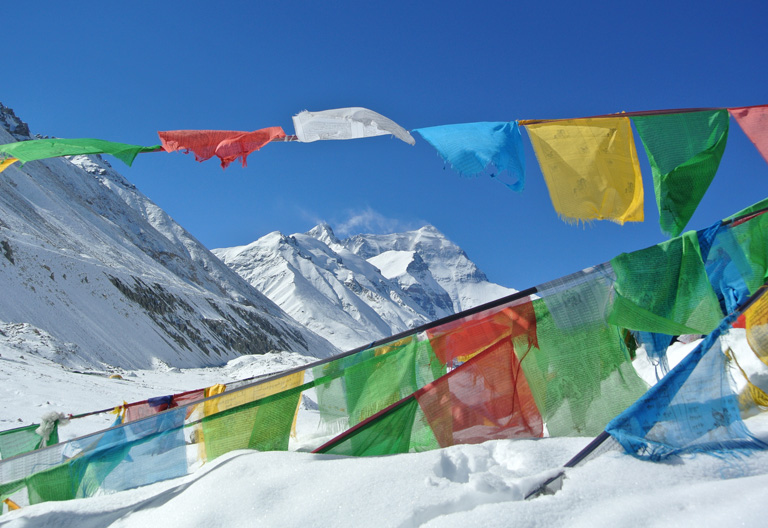
Lhasa / Gyantse / Shigatse / Everest / Lhasa
7 Days Mount Everest In Brief Tour from Lhasa
Highlights: Yamdrok Lake, Palcho Monastery, Everest Base Camp




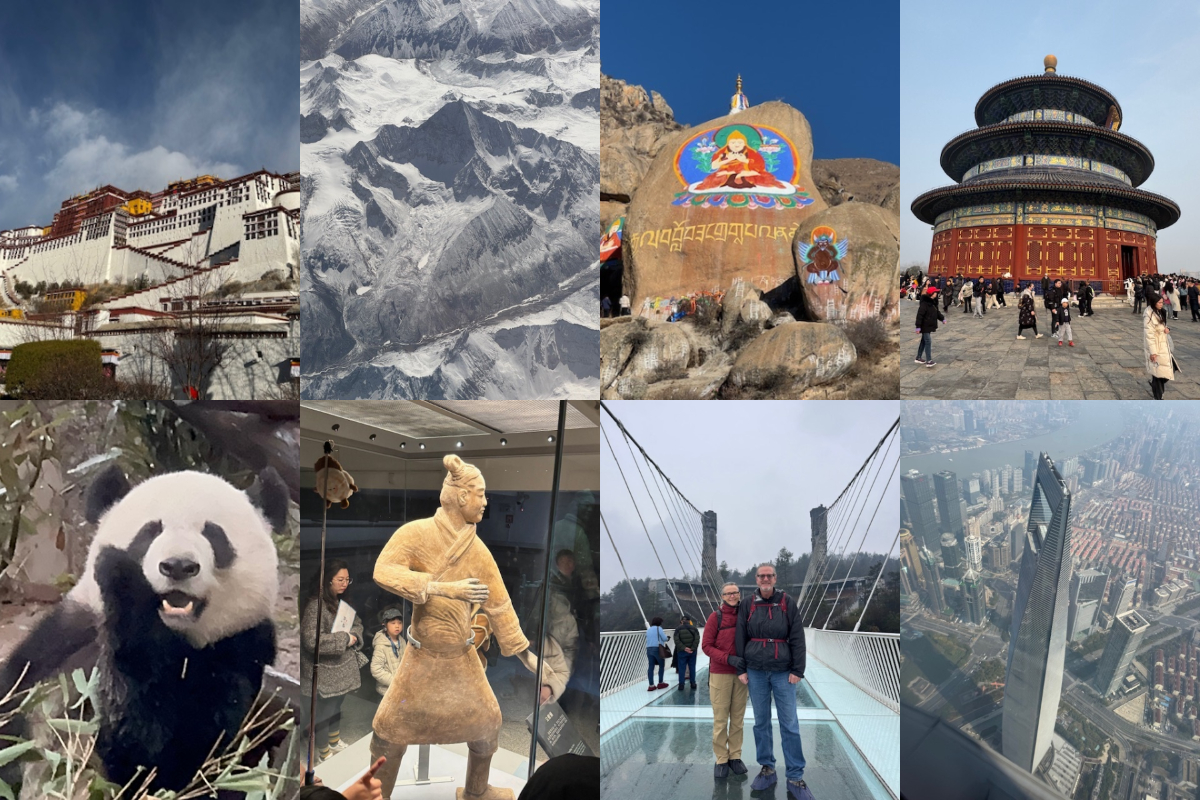

 Karen
Karen Wonder
Wonder Jack
Jack Rita
Rita Johnson
Johnson Vivien
Vivien Wing
Wing Ariel
Ariel Leo
Leo Tracy
Tracy Evelyn
Evelyn April
April Phoebe
Phoebe Kelly
Kelly Shirley
Shirley Reya
Reya Juliet
Juliet Elk
Elk Felix
Felix Sean
Sean